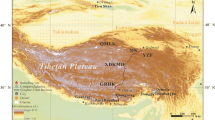Abstract
The analysis of the major ions, lead and cadmium has been performed for snow-pit samples collected from the Arctic, the Qinghai-Tibetan Plateau and the Antarctic Ice Sheet. These snow pits were excavated respectively from the snowpack in Canadian Northwest Territory (NWT) and the central Arctic, three glaciers on the Qinghai-Tibetan Plateau and surface snow along the route of the International Trans-Antarctic Expedition (ITAE). The source regions for the lead pollution of central Arctic have been identified by analyzing of stable lead isotopic ratios, meteorological and atmospheric chemistry studies. It shows that the central Arctic is still under intensive lead input, despite the fact that lead content in Greenland Ice Sheet displays a rapid decreasing since the 1970s due to US and some European countries’ campaigns to reduce lead-containing gasoline-additives. This is because there are multiple lead sources for the central Arctic, including the countries that have not performed gasoline-additives reducing. The backgrounds of atmospheric aerosol compositions, as well as the concentrations of lead and cadmium in precipitation of the early 1990s, are contrasted among the Arctic, Antarctica and Qinghai-Tibetan Plateau. The measured lead content in the snowfall at the typical sites of the three regions is divided into natural (background) and anthropogenic components. It is found that natural lead concentration (mainly crustal and/or sea-salt lead) is roughly equal among the three regions (< 3×1012g · g1). However, the percentage of the natural lead to the measured lead is negligible in precipitation in the central Arctic and the Qinghai-Tibetan Plateau, while it is considerable in Antarctic precipitation. The anthropogenic component of lead (>50% in Antarctic precipitation, >97% in the Arctic and the Qinghai-Tibetan Plateau ) is mainly responsible for the lead input to both polar regions and to the Qinghai-Tibetan Plateau. Lead pollution may have spread into the whole troposphere and the most remote regions on earth.
Similar content being viewed by others

References
Murozumi, M., Chow, T. J., Patterson, C., Chemical concentrations of pollutant lead aerosols, terrestrial dusts and sea salts, Greenland and Antarctic snow strata, Geochim. Cosmochim. Acta, 1969, 33: 1247.
Wolff, E. W., Reviews: signals of atmospheric pollution in polar snow and ice, Antarctic Science, 1990, 2: 189.
Wolff, E. W., Peel, D. A., Concentrations of cadmium, copper, lead and zinc in snow from near Dye 3 in south Greenland, Annals of Glaciology, 1988, 10: 193.
Scarponi, G., Barbante, C., Turetta, C. et al., Chemical contamination of Antarctic snow: the case of lead, Microchemical Journal, 1997, 55: 24.
Zhang, S., Trace elements in snow from high altitude of Everest regions, Bulletin of Chinese Geography (in Chinese with English abstract), 1979, 94: 13.
Wang, P., Luo, H. Z., Trace elements in snow and ice on Xiquntai, Mt. Tuomuer, Journal of Glaciology and Geocryology (in Chinese with English abstract), 1980, 2: 77.
Wang, P., Trace elements in snow and ice on Halahu Glacier, Friendship Peak, Mt. Altai, Journal of Glaciology and Geocryology (in Chinese with English abstract), 1983, 5: 63.
Xiao, C., Qin, D., An introduction of snow chemistry investigation during 1995 China’s First North Pole Scientific Expedition, Advance in Earth Sciences (in Chinese), 1996, 11: 318.
Qin, D., Ren, J., Sun, J. et al., Concentration and environmental significance of lead in surface snow of Antarctic Ice Sheet, Science in China, Ser. B, 1995, 38: 623.
Xiao, C., Qin, D., Li, Y. et al., Main pollution sources of central Arctic revealed by lead and its isotopic ratios recorded in snow, Chinese Science Bulletin, 1998, 43: 829.
Qin, D., Report on Glaciological Research of the 1990 International Trans-Antarctic Expedition (1989–1994) (in Chinese) (ed. Qin, D.), Beijing: Science Press, 1995.
Chang, C., Krishnamurti, T. N., Monsoon Meteorology, New York: Oxford University Press, 1987.
Barry, R.G., Chorely, R. J., Atmosphere, Weather and Climate (eds. Barry, R. G., Chorely, R. J.), 4th ed., New York: Methuen, 1992.
Rahn, K. A., Relative importance of North America and Eurasia as sources of Arctic aerosol, Atmospheric Environment, 1981, 15: 1457.
Barrie, L. A., Arctic air chemistry: an overview, in Arctic Air Pollution (ed. Stonehouse, B.), New York: Cambridge University Press, 1986.
Boutron, C. F., Gorlach, U., Candelone, J. P. et al., Decrease in anthropogenic lead, cadmium and zinc in Greenland snows since the late 1960s, Nature, 1991, 353: 153.
Suttie, E. D., Wolff, E. W., Seasonal input of heavy metals to Antarctic snow, Tellus, 1992, 44b: 351.
Yao, T., Ding, L., Pu, J. et al., δ18O in snowfall of Mt. Tanggula (Qinghai-Tibetan Plateau), and its relationship with sources of precipitation, Chinese Science Bulletin (in Chinese), 1991, 36: 1570.
Suttie, E. D., Wolff, E. W., The local deposition of heavy metal emissions from point sources in Antarctica, Atmospheric Environment, 1993, 27A: 1833.
Author information
Authors and Affiliations
Corresponding author
About this article
Cite this article
Xiao, C., Qin, D., Yao, T. et al. Global pollution shown by lead and cadmium contents in precipitation of polar regions and Qinghai-Tibetan Plateau. Chin.Sci.Bull. 45, 847–853 (2000). https://doi.org/10.1007/BF02887416
Received:
Issue Date:
DOI: https://doi.org/10.1007/BF02887416



